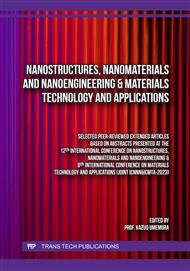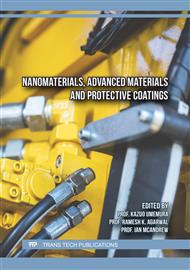[1]
X. Zhao, X. Xu, C Ai, L. Yan, C Jiang, J Shi. Advantages of silver nanoparticles synthesized by microorganisms in antibacterial activity: Nanotechnol. Plant Prot Vol. 29 (2022), pp.571-586.
DOI: 10.1016/b978-0-12-824508-8.00005-8
Google Scholar
[2]
S. Iravani, H. Korbekandi, S. Mirmohammadi, B. Zolfaghari. Synthesis of silver nanoparticles: chemical, physical and biological methods: Res Pharm Sci Vol. 6 (2014), pp.385-406.
Google Scholar
[3]
B. Aragaw, M. Alula, S. Majoni, K. King'ondu. Chapter 2 chemical synthesis of silver nanoparticles: Nanotechnol. Plant Prot Vol. 29 (2022), pp.21-53.
DOI: 10.1016/b978-0-12-824508-8.00017-4
Google Scholar
[4]
K. Chitbanyong, S. Pitiphatharaworachot, S. Pisutpiched, S. Khantayanuwong, B. Puangsin, Characterization of bamboo nanocellulose prepared by TEMPO-mediated oxidation: Bioresour Vol. 13 (2018), pp.4440-4454.
DOI: 10.15376/biores.13.2.4440-4454
Google Scholar
[5]
S. Tanpichai, E. Wimolmal, Facile single-step preparation of cellulose nanofibers by TEMPO-mediated oxidation and their Nanocomposites: J. Nat. Fibers Vol. 19 (2022), pp.10094-10110.
DOI: 10.1080/15440478.2021.1993483
Google Scholar
[6]
B. Puangsin, K. Chitbanyong, P. Yimlamai, S. Khantayanuwong, S. Pisutpiched, A. Isogai, Silver-nanoparticle-containing handsheets for antimicrobial applications: Cellul Vol. 29 (2022), pp.2005-2016.
DOI: 10.1007/s10570-021-04403-7
Google Scholar
[7]
Ri. Baron, S. Coseri, Preparation of water-soluble cellulose derivatives using TEMPO radical-mediated oxidation at extended reaction time: React. Funct. Polym Vol. 157 (2020), p.104768.
DOI: 10.1016/j.reactfunctpolym.2020.104768
Google Scholar
[8]
B. Wu, B. Geng, Y. Chen, H. Liu, G. Li, Q. Wu, Preparation and characteristics of TEMPO-oxidized cellulose nanofibrils from bamboo pulp and their oxygen-barrier application in PLA films: Front Chem Sci Eng Vol. 11 (2017), pp.554-563.
DOI: 10.1007/s11705-017-1673-8
Google Scholar
[9]
A. Isogai, T. Saito, H. Fukuzumi, TEMPO-oxidized cellulose nanofibers: Nanoscale Vol. 3 (2011), pp.71-85.
DOI: 10.1039/c0nr00583e
Google Scholar
[10]
E. Rodríguez-León1, R. Iñiguez-Palomares, R.E. Navarro, R. Herrera-Urbina, J. Tánori, C. Iñiguez-Palomares, A. Maldonado. Synthesis of silver nanoparticles using reducing agents obtained from natural sources (Rumex hymenosepalus extracts): Nanoscale Res. Lett Vol. 8 (2013), pp.571-586.
DOI: 10.1186/1556-276x-8-318
Google Scholar
[11]
S. Kwon, W. Lee, JW. Choi, N. Bumbudsanpharoke, S. Ko, A facile fabrication and characterization of cellulose-silver nanoparticle composite sheets for an antimicrobial food packaging: FRONT NUTR Vol. 8 (2021), p.778310.
DOI: 10.3389/fnut.2021.778310
Google Scholar
[12]
EI. Sherbiny, G.M. Abou EI-Nour, S.A. Askar, N.H. Mohammad, A.A. Hammad, solar radiation-induced synthesis of bacterial cellulose/silver nanoparticles (BC/AgNPs) composite using BC as reducing and capping agent: Bioprocess Biosyst Eng Vol. 45 (2022), pp.257-268.
DOI: 10.1007/s00449-021-02655-y
Google Scholar
[13]
Z. Zhang, G. Yang, M. He, L. Qi, X. Li, J. Chen. Synthesis of silver nanoparticles and detection of glucose via chemical reduction with nanocellulose as carrier and stabilizer: Int. J. Mol. Sci Vol. 23 (2022), p.15345.
DOI: 10.3390/ijms232315345
Google Scholar



